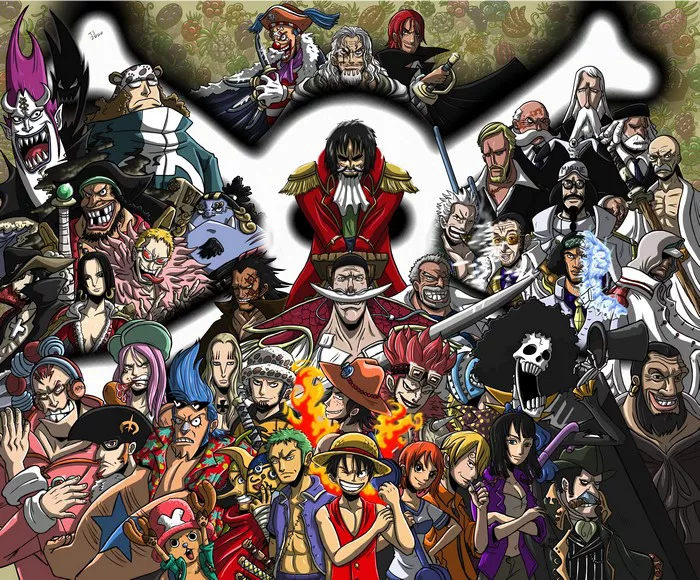One Piece,” the brainchild of Eiichiro Oda, is not only one of the longest-running manga and anime series but also one of the most intricate, featuring a vast array of characters and organizations. Among these, the admirals of the Marine Headquarters stand out due to their significant roles in the overarching narrative. The admirals represent the pinnacle of power and authority within the Marines and play crucial roles in the enforcement of justice on the seas of the “One Piece” world.
Understanding the Structure of the Marines
The Role and Purpose of the Marines:
The Marines act as the World Government’s military sea force, tasked with law enforcement, international security, and military operations. Their primary objective is maintaining order and justice, serving as one of the main antagonistic forces against pirates.
Hierarchy and Command in the Marines:
At the top of the Marine hierarchy sits the Fleet Admiral, followed by the Admirals, who play central roles in strategic decisions and frontline battles. Below the Admirals are Vice Admirals, Rear Admirals, Commodores, Captains, Commanders, and Lieutenants, among other ranks.
The Admirals of the “One Piece” World
Criteria for Becoming an Admiral:
Admirals are chosen not only for their overwhelming strength but also for their tactical acumen and loyalty to the principles of the World Government. They are expected to embody the justice that the Marines stand for, although interpretations of this justice vary significantly among the admirals.
The Original Admirals at the Series’ Outset
Admiral Aokiji (Kuzan):
Kuzan, known as Aokiji, wields the Hie Hie no Mi, a Devil Fruit that allows him to create, control, and become ice. Aokiji’s philosophy of “Lazy Justice” means he avoids unnecessary conflict and values life, which occasionally puts him at odds with his duties.
Admiral Kizaru (Borsalino):
Kizaru, whose real name is Borsalino, uses the Pika Pika no Mi, enabling him to manipulate and turn into light. Known for his laid-back and mocking attitude, Kizaru’s form of justice tends to be as swift and unstoppable as light itself.
Admiral Akainu (Sakazuki):
The most militant of the original admirals, Sakazuki, known as Akainu, possesses the Magu Magu no Mi, which allows him to produce and manipulate magma. He believes in “Absolute Justice” and is willing to take any measures, no matter how drastic, to extinguish what he perceives as evil.
Post-Timeskip Admirals
Following significant events in the series, including a pivotal battle at Marineford and the subsequent timeskip, changes occur within the ranks of the Admirals:
Admiral Fujitora (Issho):
Introduced post-timeskip, Issho, also known as Fujitora, has the power of the Zushi Zushi no Mi, enabling him to manipulate gravity. Blind but extraordinarily insightful, Fujitora wishes to see an end to the Shichibukai system and advocates for a more humane form of justice.
Admiral Ryokugyu (Green Bull):
Ryokugyu, whose real name remains undisclosed, is another post-timeskip Admiral about whom much is still unknown, including the specifics of his Devil Fruit powers. What is clear is his dedication to the new age policies of the Marines under the command of Fleet Admiral Akainu.
Fleet Admirals and Their Impact
Fleet Admiral Sengoku:
Prior to his retirement, Sengoku, the Fleet Admiral, directed Marine operations with a strategy that mixed moral conviction and pragmatic force. His ability to command the respect of both pirates and Marines alike made him a formidable leader.
Fleet Admiral Akainu (Sakazuki):
After Sengoku’s retirement, Akainu took over as Fleet Admiral. His leadership marked a darker turn for the Marines, emphasizing a more aggressive and absolute stance against piracy.
The Philosophy of Justice Among Admirals
Diverse Interpretations of Justice:
Each Admiral brings a unique interpretation of justice, influencing their decisions and actions. From Kuzan’s more merciful approach to Sakazuki’s uncompromising severity, these differing philosophies often lead to internal conflicts within the Marines and impact their external relations.
Impact of These Philosophies:
The conflicting views on justice among the Admirals are not just theoretical but affect real-world operations. They determine the strategies employed in significant battles, engagements with pirates, and the overall approach to maintaining order in the chaotic world of “One Piece.”
Admirals and Major Story Arcs
Key Battles and Conflicts:
Admirals are central figures in many of the series’ most important arcs, including the Battle of Marineford, which significantly altered the geopolitical landscape of the “One Piece” world. Their actions during these events have profound repercussions on the balance of power among pirates, the Marines, and the World Government.
Character Development and Depth:
Each Admiral is not only a powerful combatant but also a deeply developed character, reflecting Oda’s skill in characterization. Through flashbacks and key dialogues, their backstories and motivations are explored, adding layers of complexity to their roles as antagonists.
Conclusion
In the universe of “One Piece,” Admirals are more than just high-ranking officials. They are pivotal to the series’ exploration of justice, power, and morality. As of the latest updates from Eiichiro Oda, the roster includes several key figures who have been instrumental in some of the series’ most critical junctures. Their influence stretches far beyond their battles, shaping the very world they inhabit. Understanding the admirals is crucial to grasping the deeper themes of “One Piece,” and their evolving roles continue to excite and challenge viewers and readers alike.

